Yamaha EXCITER 135, EXCITER Manual

O w n e r ' s / O p e r a t o r ' s M a n u a l
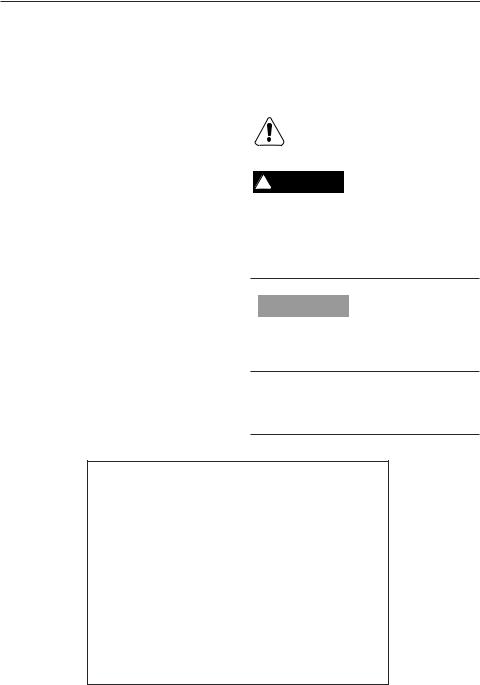
TO THE OWNER
Thank you for choosing a Yamaha Jet Boat. This Owner’s Manual contains information you will need for proper operation, maintenance, and care. A thorough understanding of these simple instructions will help you to obtain maximum enjoyment from your new Yamaha. If you have any questions about the operation or maintenance of your Jet Boat, please consult a Yamaha dealer.
YAMAHA MOTOR CORPORATION, U.S.A.
Because Yamaha has a policy of continuing product improvement, this product may not be exactly as described in this Owner’s Manual. Specifications are subject to change without notice.
This manual should be considered a permanent part of this Jet Boat and should remain with it even if the boat is subsequently sold.
IMPORTANT MANUAL INFORMATION:
In this manual, information of particular importance is distinguished in the following ways:
The Safety Alert Symbol means
ATTENTION! BECOME ALERT!
YOUR SAFETY IS INVOLVED!
 WARNING ________________
WARNING ________________
Failure to follow WARNING instructions could result in severe injury or death to the machine operator, a bystander, or a person inspecting or repairing the Jet Boat.
CAUTION: _______________
A CAUTION indicates special precautions that must be taken to avoid damage to the Jet Boat.
NOTE:_________________________
A NOTE provides key information to make procedures easier or clearer.
EXCITER SE JET BOAT (EXS1200X) OWNER’S/OPERATOR’S MANUAL
© 1998 by Yamaha Motor Corporation, U.S.A. 1st Edition, July 1998
All rights reserved. Any reprinting or unauthorized use
without the written permission of Yamaha Motor Corporation, U.S.A. is expressly prohibited. Printed in U.S.A.
LIT-18626-03-53
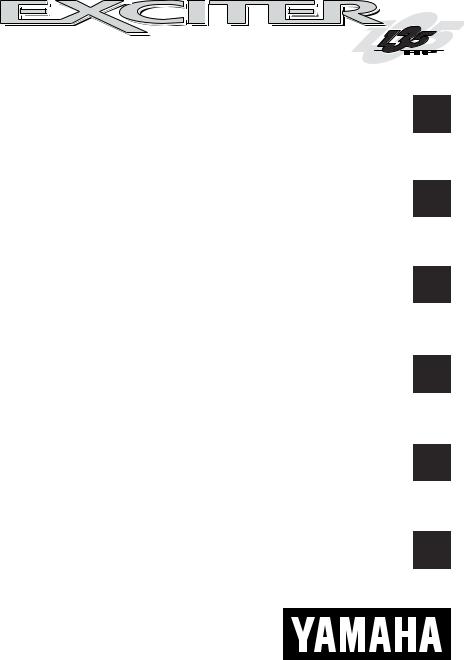
SAFETY INFORMATION
FEATURES & FUNCTIONS
OPERATION
MAINTENANCE & CARE
TROUBLESHOOTING & SPECIAL PROCEDURES
1
2
3
4
5
CONSUMER INFORMATION 6

Chapter 1
SAFETY INFORMATION
IDENTIFICATION NUMBER RECORDS . . . . . . . . . . . . . . . . . . . . . . . . . . . .1-1
Primary I.D. Number . . . . . . . . . . . . . . . . . . . . . . . . . . . . . . . . . . . . . . .1-1
Hull Identification Number (H.I.N.) . . . . . . . . . . . . . . . . . . . . . . . . . . . . .1-1
Engine Number . . . . . . . . . . . . . . . . . . . . . . . . . . . . . . . . . . . . . . . . . . .1-1
IMPORTANT LABELS . . . . . . . . . . . . . . . . . . . . . . . . . . . . . . . . . . . . . . . . . .1-2
Location . . . . . . . . . . . . . . . . . . . . . . . . . . . . . . . . . . . . . . . . . . . . . . . . .1-2
Labels . . . . . . . . . . . . . . . . . . . . . . . . . . . . . . . . . . . . . . . . . . . . . . . . . .1-3
SAFETY INFORMATION . . . . . . . . . . . . . . . . . . . . . . . . . . . . . . . . . . . . . . . .1-7
Limitations On Who May Operate the Jet Boat . . . . . . . . . . . . . . . . . . .1-7
Required Equipment . . . . . . . . . . . . . . . . . . . . . . . . . . . . . . . . . . . . . . .1-8
Additional Equipment Recommendations . . . . . . . . . . . . . . . . . . . . . . .1-8
Apparel . . . . . . . . . . . . . . . . . . . . . . . . . . . . . . . . . . . . . . . . . . . . . . . . . .1-9
Operational Requirements . . . . . . . . . . . . . . . . . . . . . . . . . . . . . . . . . . .1-9
Jet Boat Characteristics . . . . . . . . . . . . . . . . . . . . . . . . . . . . . . . . . . . .1-11
Cruising Limitations . . . . . . . . . . . . . . . . . . . . . . . . . . . . . . . . . . . . . . .1-12
Night Operation . . . . . . . . . . . . . . . . . . . . . . . . . . . . . . . . . . . . . . . . . .1-13
Waterskiing . . . . . . . . . . . . . . . . . . . . . . . . . . . . . . . . . . . . . . . . . . . . .1-14
BASIC BOATING RULES . . . . . . . . . . . . . . . . . . . . . . . . . . . . . . . . . . . . . . .1-15
Rules of the Road . . . . . . . . . . . . . . . . . . . . . . . . . . . . . . . . . . . . . . . .1-15
Steering and Sailing and Sound Signals . . . . . . . . . . . . . . . . . . . . . . .1-15
Rules When Encountering Vessels . . . . . . . . . . . . . . . . . . . . . . . . . . .1-16
Other Special Situations . . . . . . . . . . . . . . . . . . . . . . . . . . . . . . . . . . .1-17
TO GET MORE BOATING SAFETY INFORMATION . . . . . . . . . . . . . . . . . .1-19
Boating Education . . . . . . . . . . . . . . . . . . . . . . . . . . . . . . . . . . . . . . . .1-19
ACCIDENT REPORTING . . . . . . . . . . . . . . . . . . . . . . . . . . . . . . . . . . . . . . .1-20
ENJOY YOUR JET BOAT RESPONSIBLY . . . . . . . . . . . . . . . . . . . . . . . . . .1-20
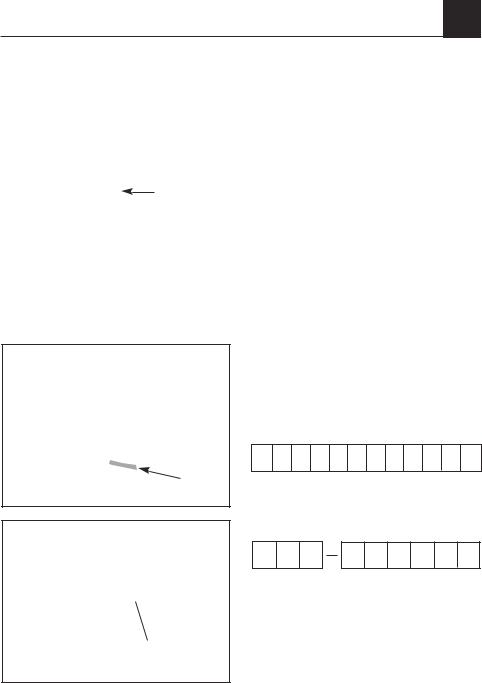
SAFETY INFORMATION 1
IDENTIFICATION
NUMBER RECORDS
|
Record your Primary I.D., H.I.N., and |
||||||||||
|
engine number in the spaces provided |
||||||||||
|
to assist you in ordering spare parts |
||||||||||
|
from your Yamaha Jet Boat dealer. Also |
||||||||||
|
record and keep these I.D. numbers in |
||||||||||
|
a separate place in case your Jet Boat |
||||||||||
is stolen. |
|||||||||||
|
PRIMARY I.D. NUMBER |
||||||||||
|
|
|
|
|
|
|
|
|
|
|
|
|
|
|
|
|
|
|
|
|
|
|
|
|
|
|
|
|
|
|
|
|
|
|
|
The Primary I.D. number is stamped on a label attached to the inside of the engine compartment.
HULL IDENTIFICATION NUMBER (H.I.N.)
The H.I.N. is stamped into the hull on the right rear corner.
ENGINE SERIAL NUMBER
The Engine Serial Number is stamped on a label attached to the back side of the electrical box.
1-1
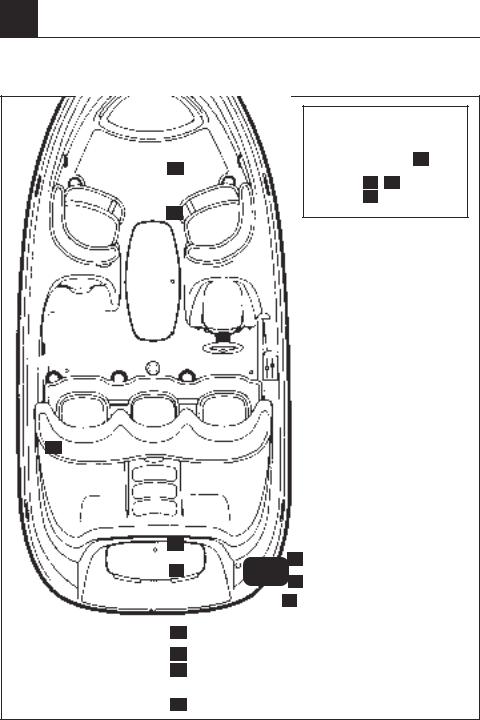
1 SAFETY INFORMATION
IMPORTANT LABELS
LOCATION
2
17
4 1
3
16
15 |
|
15 |
15
|
|
5 |
14 |
|
|
|
|
18
6
9
7
8
10
11
12
13
1-2
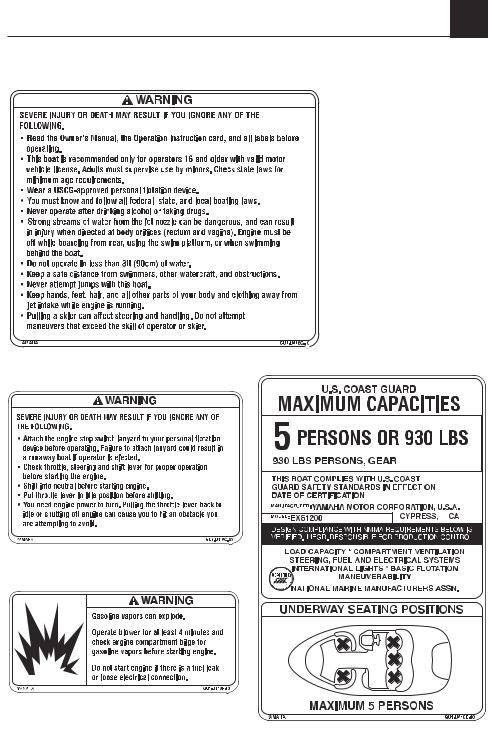
SAFETY INFORMATION 1
IMPORTANT LABELS
|
|
|
1-3
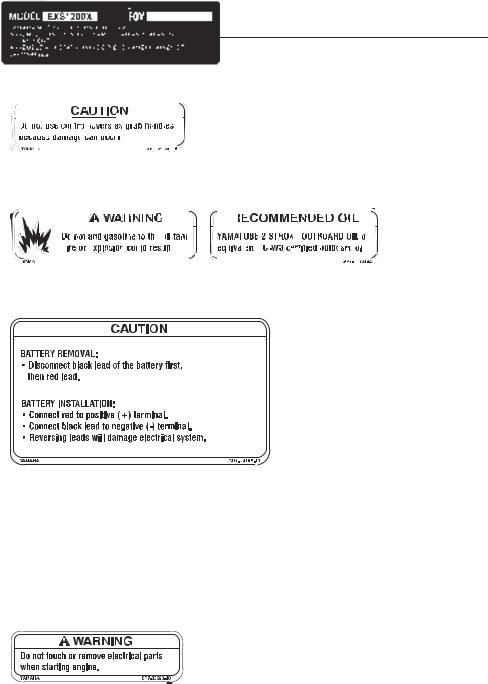
1 SAFETY INFORMATION
IMPORTANT LABELS
1-4
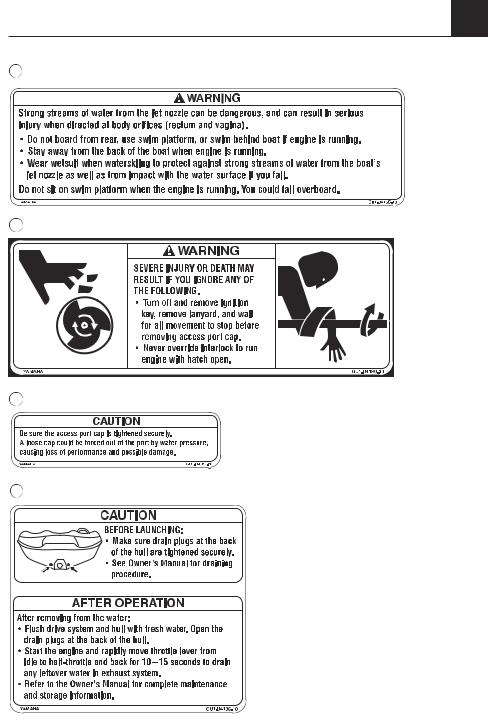
SAFETY INFORMATION 1
IMPORTANT LABELS
10
11
12
13
1-5

1 SAFETY INFORMATION
IMPORTANT LABELS
14
15
16
17 |
18 |
1-6

SAFETY INFORMATION 1
SAFETY
INFORMATION
 WARNING ________________
WARNING ________________
SEVERE INJURY OR DEATH MAY RESULT IF YOU IGNORE ANY OF THE FOLLOWING SAFETY INFORMATION.
●Before operating the Jet Boat, read this entire manual, the Operation Instruction card, and all warning labels on the Jet Boat. Also view the Basic Orientation video tape. These materials should give you an understanding of the boat and its operation.
Never allow anyone to operate this Jet Boat until they too have read this Owner's Manual, the Operation Instruction card, all warning labels, and, if possible, watched the video.
LIMITATIONS ON WHO MAY OPERATE THE JET BOAT
●This boat is recommended only for operators 16 and older with a valid motor vehicle license.
Even though a motor vehicle operator's license is not required for Jet Boat operation in most states, it is one indicator that the operator has previously demonstrated a reasonable degree of maturity, responsibility, and good judgment.
A responsible adult must supervise operation of this boat by minors. Many states have minimum age and edu-
cation requirements. Always check state and local boating laws before you operate the Jet Boat.
●The operator is responsible for the safety of his or her passengers as well as his or her own personal safety.
●The operator is responsible for the safety of his or her passengers as well as his or her own personal safety.
●Your Jet Boat is designed to carry the operator, up to four passengers, and cargo, as long as the total weight does not exceed the maximum load capacity. Never have more than five people on board. Weight distribution affects performance. Keep weight in the boat low and evenly distributed. Remove any unnecessary cargo and store it on shore.
ATTENTION:__________________
Maximum load capacity: 930 lb (421 kg)
Includes weight of operator, passengers, and any cargo.
1-7

1 SAFETY INFORMATION
REQUIRED EQUIPMENT
The U.S. Coast Guard (USCG) has regulations which describe minimum standards of safety. You must comply with these regulations, which apply to boats like your Jet Boat which are less than 26 feet long.
●Personal Flotation Devices (PFDs): Type I, II, or III as required for all people on board (see “Apparel” for more information), plus at least one Type IV (throwable type).
●Fire Extinguisher:
At least one B-1 type hand-held portable fire extinguisher.
●Visual Distress Signals:
Having USCG-approved visual distress signals on board is recommended under all circumstances, and required if you will be operating on coastal waters, the Great Lakes, territorial seas and waters connected to them. Contact your dealer or the Coast Guard for more information.
●Sound Signalling Device:
Your Jet Boat is equipped with a horn which can be used to signal other boats. See “Rules of the Road” for more information.
●Navigation Lights:
Your Jet Boat is equipped with navigation lights for use between sunset and sunrise, and during periods of reduced visibility, such as fog. Be sure these lights are working and are turned on when necessary (see page 2-12 and 3-9 for more information).
ADDITIONAL EQUIPMENT RECOMMENDATIONS
The following equipment can help make your boating experience safer and more enjoyable:
●Mooring fenders and lines
●Anchor with suitable line (a “Danforth” type anchor and line that is at least 6-times the depth of the water where you will drop anchor are recommended)
●Manual-type bilge pump
●First Aid kit
●Waterproof Flashlight with extra batteries
●Tool kit with assorted screwdrivers, pliers, wrenches (including metric sizes), and electrical tape
●Oar or paddle (look for one with a boat hook on the other end)
●Spare parts, such as an extra set of spark plugs and fuses
●Navigation charts for the waters where you will be boating
●Tow rope
1-8

SAFETY INFORMATION 1
APPAREL
●Because of the drowning hazards associated with water sports, the operator and passengers must always wear a U.S. Coast Guardapproved vest-type personal flotation device (PFD). Be sure the PFD is properly fitting and in good condition.
●You should consider wearing slipresistant deck shoes or water shoes for more secure footing while boating.
●Waterskiers and others engaging in water sports behind the boat must wear a wetsuit. A wetsuit can help protect against strong streams of water from the jet nozzle or impact from the water surface. These hazards could cause severe injuries to certain body orifices (rectum and vagina).
●Depending upon operating conditions, you may consider wearing a wetsuit while boating. A wet suit can help protect against hypothermia (low body temperature) when there is water spray coming into the boat, particularly if you are operating in cold water or air temperature.
●You might also consider gloves designed for water sports to help protect hands during operation, as well as while launching and docking your boat.
●You may want to consider eye protection. Water spray could get in your eyes in some circumstances which could affect your vision.
OPERATIONAL REQUIREMENTS
●Operating your Jet Boat requires skills acquired only through practice over a period of time. Take the time to learn the basic operating techniques well, before attempting more difficult maneuvers. Your Jet Boat is capable of truly exhilarating performance. Don’t push your boat to the limits beyond your ability. The operator should have at least 10 hours of experience with the boat before any abrupt acceleration, sharp turns, or operation at full speed.
●NEVER operate the boat after consuming alcohol or taking drugs.
1-9
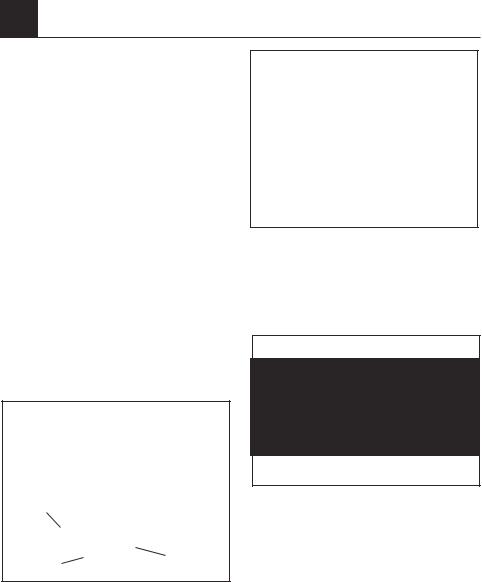
1 SAFETY INFORMATION
●Always perform the pre-operation checks on page 3-4 before operating to be sure your equipment is working properly.
●The operator should always attach the engine stop switch lanyard (cable) to his PFD so that the engine will stop if the operator accidentally leaves the helm. Failure to attach the lanyard could result in a runaway boat if the operator is ejected.
Be sure the lanyard is not wrapped around the steering wheel or tangled in the controls which would prevent the lanyard from pulling away.
To prevent accidental starting of the engine, always remove the lanyard from the stop switch when the engine is not running.
Engine stop switch
Engine stop switch lanyard
Lanyard clipped to PFD
●Passengers must always sit in a designated seating area, place feet on the deck, and use the hand grips provided while the boat is in motion.
UNDERWAY SEATING POSITIONS
MAXIMUM 5 PERSONS
●Always watch carefully for swimmers. Stay away from swimming areas. Swimmers are hard to see and you could accidentally hit someone in the water.
●Avoid being hit by another boat! Always watch for traffic; other boaters may not be watching for you. If they don't see you, or you maneuver more quickly than other boaters expect, you risk a collision.
1-10

SAFETY INFORMATION 1
●Maintain a safe distance from other boats or watercraft, and also watch for boat's ski ropes or fishing lines. Obey the "Rules of the Road" (see page 1-15), and be sure to check behind you before making a turn.
●If you are pregnant or in poor health, ask your doctor's advice on whether it is safe for you to ride this Jet Boat.
●Do not attempt to modify this Jet Boat! Modifications to your boat may reduce safety and reliability, and may make the boat illegal for use.
JET BOAT CHARACTERISTICS
●Jet thrust turns the Jet Boat. If you are going faster than idle speeds, you must use engine power to turn. If you pull the throttle lever back to idle or shut off the engine, you cannot turn – even if you turn the wheel. Practice turning in an open area without obstructions until you have a good feel for this maneuver.
Yamaha Jet Boats are water-jet propelled. The jet pump is directly connected to the engine. This means that jet thrust will produce some boat movement whenever the engine is running. The Jet Boat has a "neutral" position, but since the Jet Boat is always producing thrust while the engine is running, some forward or reverse movement may occur.
●Boats, including your Jet Boat, do not have brakes. Pull the throttle lever back to idle or stop the engine and allow water resistance to slow the boat down. Remember, however, that you have no steering control without throttle. Do not use Reverse to try to slow down from speed, because you could be ejected, the boat could be flooded, or damage could occur to the shift mechanism.
Reverse can be used to slow down or stop during slow-speed maneuvering, such as when docking. Once the engine is idling, shift to Reverse and gradually increase engine speed to slow down or stop.
●Keep the following in mind when using reverse:
Reverse is for launching and low speed maneuvering only. Shift only when the engine is idling or off. Do not shift while applying throttle. Make sure there are no obstacles or people behind you before shifting into reverse.
1-11

1 SAFETY INFORMATION
●Keep hands, feet, hair, and all other parts of your body and clothing away from jet intakes on the bottom of the hull while engine is running because they could be caught in the intake. Stop the engine and remove the lanyard before removing any debris or weeds which may have collected around the jet intake.
Refer to the Jet Pump Clean-Out procedures on page 5-4 for further information.
CRUISING LIMITATIONS
●Do not try to jump other boat's wakes or follow another boat or watercraft too closely or you will increase your chance of colliding with other boats. Do not go over a water-ski jump, or attempt any other kind of jumping maneuver with the boat, since you risk injuring yourself or damaging your Jet Boat.
●Watch for dangerous underwater obstacles when boating in shallow water. Never operate in water that is less than 3 ft (90 cm) deep.
●Do not board from the rear, use swim platform, or swim behind boat when the engine is running. Strong streams of water from the jet nozzle can be dangerous and can result in serious injury when directed at body orifices (rectum and vagina).
●Never insert any object in the jet pump outlet.
3 FT (90 CM)
●Do not operate the boat in rough water, bad weather or when visibility is poor; this may lead to an accident causing injury or death. Operation in rough water can crack the hull or damage internal parts.
1-12
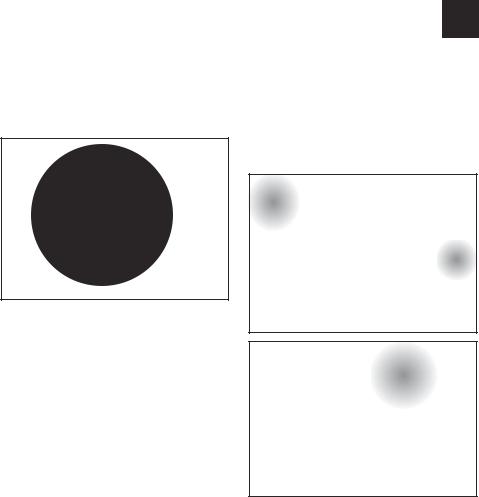
Be alert to the possibility of adverse weather. Take note of marine weather forecasts and the prevailing weather conditions before setting out in your Jet Boat.
●Leave a “float plan” with a responsible person on shore. Tell where you plan to go and when you plan to arrive, and provide a description of your boat. Advise this person if your plans change and also when you arrive to prevent false alarms. A sample float plan is included on page 6-6.
SAFETY INFORMATION 1
NIGHT OPERATION
●When using your Jet Boat before dawn and after dusk, you must have both bow and stern lights operating. When at anchor in the dark, the stern light must be lit. See page 2-12 for instructions.
1-13
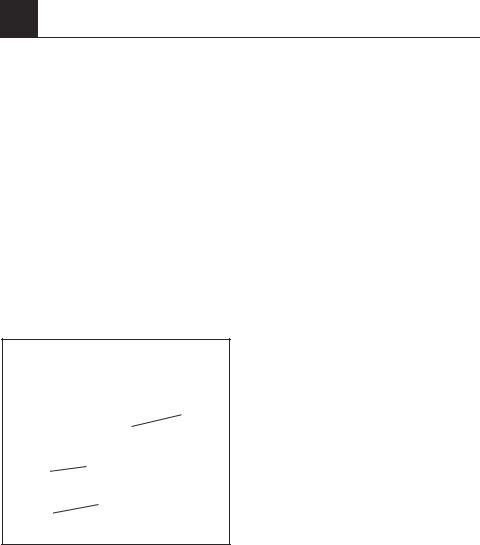
1 SAFETY INFORMATION
WATERSKIING
You can use the Jet Boat to tow a waterskier, using the tow eye provided. Do not attach the tow rope to any other location on the boat.
It is the boat operator’s responsibility to be alert to the safety of the waterskier and others. Know and follow all state and local waterskiing regulations in effect for the waters in which you will be operating. The following are some important considerations for minimizing risks while waterskiing:
●Wear an approved PFD, preferably a brightly colored one so boat operators can see you.
PFD
Gloves
Wetsuit
●Wear a wetsuit when waterskiing to protect against injury to body orifices (rectum and vagina) from impact with the water surface if you fall or strong streams of water from the boat’s jet nozzles while in the water behind
the boat. A wetsuit can also help protect against hypothermia (low body temperature) and abrasions.
●A second person should be on board as an observer to watch the skier; in most states it is required by law. Let the skier direct the operator’s control of boat speed and direction with hand signals. The observer should sit securely in the seat, hold onto the handles or straps provided, and place feet firmly on the floor for proper balance while facing to the rear to watch the skier’s hand signals and condition. The front, port-side seat has a handle for a backward-facing observer.
●When preparing to pull a skier, operate the Jet Boat at the slowest possible speed until the boat is well away from the skier and slack in the tow rope is taken up. Be careful that the rope is not looped around anything. After checking that the skier is ready and there is no traffic or obstacles, apply enough throttle to raise the skier.
●Make smooth, wide turns. The Jet Boat is capable of very sharp turns which could exceed the abilities of the skier. Keep the skier at least 150 feet (49m), about twice the distance of a standard tow-rope from any potential hazard.
●Be alert to the hazard from the handle snapping back into the boat when the skier falls or is unable to get up on the skis.
1-14

SAFETY INFORMATION 1
BASIC BOATING
RULES
RULES OF THE ROAD
Your Yamaha Jet Boat is legally considered a power boat. Operation of the Jet Boat must be in accordance with the rules and regulations governing the waterway on which it is used.
Just as there are rules which apply when you are driving on streets and highways, there are waterway rules which apply when you are operating your Jet Boat. These rules are used internationally, and are also enforced by the United States Coast Guard and local agencies. You should be aware of these rules, and follow them whenever you encounter another vessel on the water.
Several sets of rules prevail according to geographic location, but are all basically the same as the International Rules of the Road. The rules presented here in your Owner's Manual are condensed, and have been provided for your convenience only. Consult your local U.S. Coast Guard Auxiliary or Department of Motor Vehicles for a complete set of rules governing the waters in which you will be using your Jet Boat.
STEERING AND SAILING RULES AND SOUND SIGNALS
Whenever two vessels on the water meet one another, one vessel has the right-of-way; it is called the "stand-on" vessel. The vessel which does not have the right-of-way is called the "give-way or "burdened" vessel. These rules determine which vessel has the right- of-way, and what each vessel should do.
Stand-On Vessel
The vessel with the right-of-way has the duty to continue its course and speed, except to avoid an immediate collision. When you maintain your direction and speed, the other vessel will be able to determine how best to avoid you.
Give-Way Vessel
The vessel which does not have the right-of-way has the duty to take positive and timely action to stay out of the way of the Stand-On vessel. Normally, you should not cross in front of the vessel with the right-of-way. You should slow down or change directions briefly and pass behind the other vessel. You should always move in such a way that the operator of the other vessel can see what you are doing.
The General Prudential Rule regarding the right-of-way is that if a collision appears unavoidable, neither boat has the right-of-way. Both boats must avoid the collision.
In other words, follow the standard rules except when a collision will occur unless both vessels try to avoid each other. If that is the case, both vessels become "Give-Way" vessels.
1-15

1 SAFETY INFORMATION
RULES WHEN ENCOUNTERING VESSELS
There are three main situations which you may encounter with other vessels which could lead to a collision unless the Steering Rules are followed:
Meeting (you are approaching another vessel head-on)
Crossing (you are travelling across the other vessel's path)
Overtaking (you are passing or being passed by another vessel)
In the following illustration, your Jet Boat is in the center. You should give the right-of-way to any vessels shown in the white area (you are the GiveWay vessel). Any vessels in the shaded area must yield to you (they are the Give-Way vessels). Both you and the meeting vessel must alter course to avoid each other.
Meeting
If you are meeting another power vessel head on, and are close enough to run the risk of collision, neither of you has the right-of-way. Both of you should alter course to avoid an accident. You should keep the other vessel on your port (left) side. This rule doesn't apply if both of you will clear one another if you continue on your set course and speed.
Crossing
When two power driven vessels are crossing each other's path close enough to run the risk of collision, the vessel which has the other on the starboard (right) side must keep out of the way of the other. If the other vessel is on your right, you must keep out of its way; you are the Give-Way vessel. If the other vessel is on your port (left) side, remember that you should maintain course and direction, provided the other vessel gives you the right-of-way as it should.
1-16
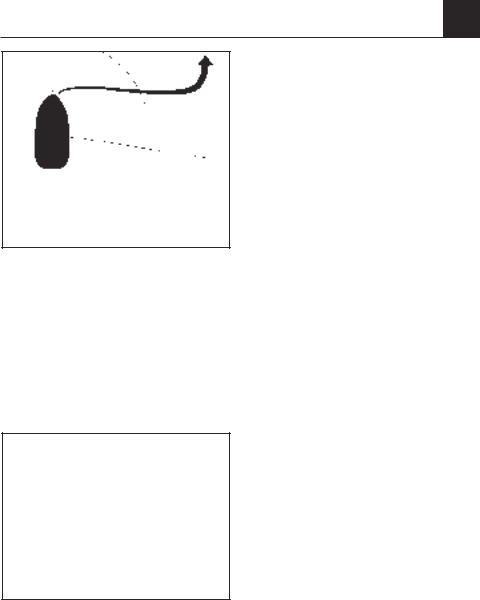
SAFETY INFORMATION 1
STAND-ON-VESSEL
GIVE-WAY-VESSEL
Overtaking
If you are passing another vessel, you are the "Give-Way" vessel. This means that the other vessel is expected to maintain its course and speed. You must stay out of its way until you are clear of it. Likewise, if another vessel is passing you, you should maintain your speed and direction so that the other vessel can steer itself around you.
GIVE-WAY
VESSEL
OTHER SPECIAL SITUATIONS
There are three other rules you should be aware of when driving your Jet Boat around other vessels.
Narrow Channels and Bends
When navigating in narrow channels, you should keep to the right when it is safe and practical to do so. If the operator of a power-driven vessel is preparing to go around a bend that may obstruct the view of other water vessels, the operator should sound a prolonged blast on the horn (4 to 6 seconds). If another vessel is around the bend, it too should sound the horn. Even if no reply is heard, however, the vessel should still proceed around the bend with caution.
Fishing Vessel Right-of-Way
All vessels which are fishing with nets, lines or trawls are considered to be "fishing vessels" under the International Rules. Vessels with trolling lines are not considered fishing vessels. Fishing vessels have the right- of-way regardless of position. Fishing vessels cannot, however, impede the passage of other vessels in narrow channels.
Sailing Vessel Right-of-Way
Sailing vessels should normally be given the right-of-way. The exceptions to this are:
1.When the sailing vessel is overtaking the power-driven vessel, the power-driven vessel has the right- of-way.
2.Sailing vessels should keep clear of any fishing vessel.
3.In a narrow channel, a sailing vessel should not hamper the safe passage of a power-driven vessel which can navigate only in such a channel.
1-17
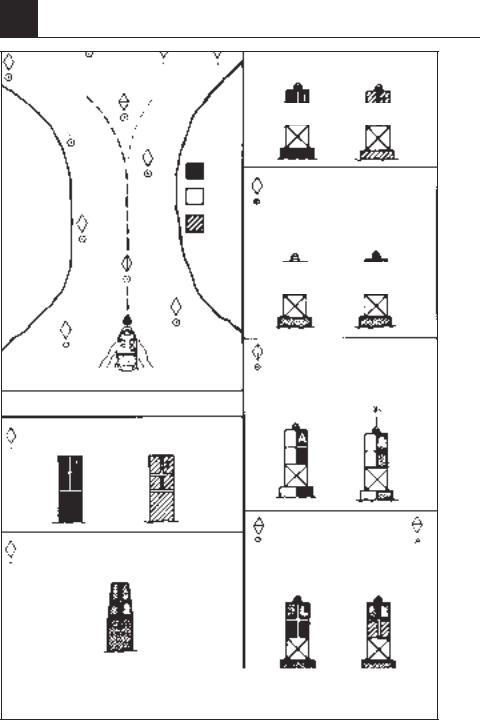
1 SAFETY INFORMATION
"7" |
MAIN |
|
CHANNEL |
|
"5" |
"6"
RB "L" or RG "L"
C "1" SECONDARY
"4"
CHANNEL"2"
MAIN CHANNEL BUOYS
"1" "3" "5" "7"
LIGHTED BUOY (Port Hand)
Odd number, increasing toward head of navigation. Leave to port (left) proceeding upstream.
|
|
White Light |
Green Light |
||||
|
|
|
|
|
|
|
|
|
|
|
OR |
|
|
|
|
|
|
|
|
|
|
|
|
|
|
|
|
|
|
||
old |
|
|
|
new |
|
||
|
|
|
|
|
|
||
|
"2" "4" "6" |
|
|
|
|
|
|
"3"
|
|
|
|
|
|
|
|
|
"A" |
|
|
|
|
|
|
"2" |
|||||||
|
|
|
|
|
|
|
|
|
|
|
|
|
|
|
|
|
"1" |
|
|
|
|
|
|
|
|
|
|
|
Proceeding toward head of |
||||||
|
|
|
|
|
navigation from seaward |
||||||
|
|
|
|
SECONDARY CHANNEL BUOYS |
|||||||
|
|
|
|
STARTS NEW NUMBERING SYSTEM |
|||||||
|
|
|
|
|
|
CAN BUOY |
|||||
C "1" |
|
|
|||||||||
|
|
Odd number. Leave to port. |
|||||||||
|
|
|
|
|
|||||||
|
|
|
|
|
|
|
|
|
|
|
|
|
|
|
|
|
|
|
OR |
|
|
|
|
|
|
|
|
|
|
|
|
|
|
|
|
|
|
|
|
|
|
|
|
|
|
|
|
|
|
|
|
|
|
|
|
|
|
|
new |
|
old |
|
|
|
|
||||||
|
|
|
NUN BUOY |
||||||||
|
|
|
|
|
|
||||||
|
|
|
|
|
|
||||||
N "2" |
|
||||||||||
|
Even number. Leave to starboard. |
||||||||||
|
|
|
|
||||||||
No change
LIGHTED BUOY (Starboard Hand)
Even number, increasing toward head of navigation. Leave to starboard (right) proceeding upstream.
|
White Light |
Red Light |
||||
|
|
|
|
|
|
|
|
|
OR |
|
|
|
|
|
|
|
|
|
|
|
|
|
|
|
|||
old |
|
|
new |
|
||
"A"
LIGHTED SAFE WATER BUOY
No number. Marks midchannel, pass on either side. Letter has no lateral significance, used for identification and location purposes.
|
|
|
|
|
|
Top Mark |
||
|
|
White Light |
White Light |
|||||
|
|
|
|
|
|
|
|
|
|
|
|
|
OR |
|
|
|
|
|
|
|
|
|
|
|
|
|
|
|
|
|
|
|
|||
old |
|
|
|
new |
|
|||
|
|
RB "L" |
||||||
|
RB "L" |
|
||||||
LIGHTED PREFERRED CHANNEL TO
PORT BUOY
No number. Topmost band red - preferred channel is to left of buoy. Letter has no lateral significance, used for identification and location purposes.
|
Red or |
Red Light |
||||
|
White Light |
|
|
|
||
|
|
|
|
|
|
|
|
|
OR |
|
|
|
|
|
|
|
|
|
|
|
|
|
|
|
|||
old |
|
|
new |
|
||
1-18

SAFETY INFORMATION 1
Reading Buoys and Other Markers
The waters of the United states are marked for safe navigation by the lateral system of buoys. Simply put, buoys and markers have an arrangement of shapes, colors, numbers and lights to show which side of the buoy a boater should pass on when navigating in a particular direction. The markings on these buoys are oriented from the perspective of being entered from seaward (the boater is going towards the port). This means that red buoys are passed on the starboard (right) side when proceeding from open water into port, and black buoys are to port left) side. When navigating out of port, your position with respect to the buoys should be reversed; red buoys should be to port and black buoys to starboard.
Many bodies of water used by boaters are entirely within the boundaries of a particular state. The Uniform State Waterway Marking System has been devised for these waters. This system uses buoys and signs with distinctive shapes and colors to show regulatory or advisory information. These markers are white with black letters and orange borders. They signify speed zones, restricted areas, danger areas, and general information.
Remember, markings may vary by geographic location. Always consult local boating authorities before driving your Jet Boat in unfamiliar waters.
TO GET MORE BOATING SAFETY INFORMATION
Be informed about boating safety. Additional publications and information can be obtained from many organizations, including the following:
United States Coast Guard
Consumer Affairs Staff (G-BC)
Office of Boating, Public, and
Consumer Affairs
U.S. Coast Guard Headquarters
Washington, D.C. 20593-0001
Boating Safety Hotline:
1-800-368-5647
BOATING EDUCATION
This manual cannot provide complete training on all aspects of boat operation. All operators of this Jet Boat are encouraged to seek additional training on boat handling and safety. Many states require operators under the age of 18 to be licensed in small boat operation and offer training and certification courses.
Many different agencies and organizations offer boating training and safety. Some of these are listed below. Check your local telephone directory for the telephone numbers and addresses in your area.
●U.S. Coast Guard Auxiliary
●American Red Cross
●National Fishing and Wildlife Foundation
●Power Squadrons
●Sports Fishing Institute
●State Boating Offices
1-19

1 SAFETY INFORMATION
ACCIDENT |
ENJOY YOUR JET |
REPORTING |
BOAT RESPONSIBLY |
Boat operators are required by law to file a Boating Accident Report with their state boating law enforcement agency if their boat has been involved in any of the following boating accidents:
1.There is loss of life or probable loss of life.
2.There is personal injury which requires medical attention beyond first aid.
3.There is damage to boats or other property which exceeds $500.00.
4.There is complete loss of a boat.
Contact local law enforcement personnel if a report is necessary.
You share the areas you enjoy when operating your Jet Boat with others and with nature. So your enjoyment includes a responsibility to treat other people, and the lands, waters, and wildlife with respect and courtesy.
Whenever and wherever you operate your Jet Boat, think of yourself as the guest of those around you. Remember, for example, that the sound of your Jet Boat may be music to you, but it could be just noise to others. And the exciting splash of your wake can make waves others won’t enjoy. Avoid boating close to shoreline homes and waterfowl nesting areas or other wildlife areas, and keep a respectful distance from fisherman, other boats, swimmers, and populated beaches. When travel in areas like these is unavoidable, drive slowly and obey all laws.
Remember that pollution can be harmful to the environment. Do not refuel or add oil where a spill could cause damage to nature. And keep your surroundings pleasant for the people and wildlife that share the waterways: don’t litter!
When you use your Jet Boat responsibly, with respect and courtesy for others, you help ensure that our waterways stay open for the enjoyment of a variety of recreational opportunities.
1-20

Chapter 2
FEATURES & FUNCTIONS
LOCATION OF MAIN COMPONENTS . . . . . . . . . . . . . . . . . . . . . . . . . . . . . .2-1
OPERATION OF CONTROLS AND OTHER FUNCTIONS . . . . . . . . . . . . . .2-5
Steering . . . . . . . . . . . . . . . . . . . . . . . . . . . . . . . . . . . . . . . . . . . . . . . .2-5
Engine Stop Switch Lanyard . . . . . . . . . . . . . . . . . . . . . . . . . . . . . . . . .2-5
Main Switch . . . . . . . . . . . . . . . . . . . . . . . . . . . . . . . . . . . . . . . . . . . . . .2-6
Throttle Lever . . . . . . . . . . . . . . . . . . . . . . . . . . . . . . . . . . . . . . . . . . . . .2-6
Shift Lever . . . . . . . . . . . . . . . . . . . . . . . . . . . . . . . . . . . . . . . . . . . . . . .2-7
Choke Knob . . . . . . . . . . . . . . . . . . . . . . . . . . . . . . . . . . . . . . . . . . . . . .2-8
Fuel Tank Filler Cap . . . . . . . . . . . . . . . . . . . . . . . . . . . . . . . . . . . . . . . .2-8
Fuel Cock . . . . . . . . . . . . . . . . . . . . . . . . . . . . . . . . . . . . . . . . . . . . . . . .2-9
Gauges . . . . . . . . . . . . . . . . . . . . . . . . . . . . . . . . . . . . . . . . . . . . . . . . .2-9
Overheat Warning System . . . . . . . . . . . . . . . . . . . . . . . . . . . . . . . . . .2-11
Switches . . . . . . . . . . . . . . . . . . . . . . . . . . . . . . . . . . . . . . . . . . . . . . . .2-12
Engine Hood . . . . . . . . . . . . . . . . . . . . . . . . . . . . . . . . . . . . . . . . . . . .2-13
Storage Compartments . . . . . . . . . . . . . . . . . . . . . . . . . . . . . . . . . . . .2-14

FEATURES & FUNCTIONS 2
LOCATION OF MAIN COMPONENTS
|
|
|
|
17 |
|
|
|
|
|
|
|
|
1 |
|
|
|
|
|
|
|
|
|
|
|
|
|
|
|||||
|
|
|
|
|
|
|
|
|
|
|
|
|
|
|
|
|
|
|
|
|
|
|
|
|
|
|
|
|
|
|||
|
|
|
|
|
|
|
|
|
|
|
|
|
|
|
|
|
|
|
|
|
|
|
|
|
|
|
|
|
|
|
|
|
|
|
|
|
|
|
|
|
|
|
|
|
|
|
|
|
|
|
|
|
|
|
|
|
|
|
|
|
2 |
||||
|
|
|
|
|
|
|
|
|
|
|
|
|
|
|
|
|
|
|
|
|
|
|
|
|
|
|
|
|
|
|
|
|
|
|
|
|
|
|
|
|
|
|
|
|
|
|
|
|
|
|
|
|
|
|
|
4 |
|||||||||
|
|
|
|
|
|
|
|
|
|
|
|
|
|
|
|
|
|
|
|
|
|
|
|
|
|
|
|
|
||||
|
10 |
|
|
|
|
|
|
|
|
|
|
|
|
|
|
|
|
|
|
|
|
|
|
|
||||||||
|
|
|
|
|
|
|
|
|
|
|
|
|
|
|
|
|
11 |
|
|
|
|
|
|
|
|
|
|
|
|
|
|
|
|
|
|
|
|
|
|
|
|
|
|
|
|
|
|
|
|
|
|
|
|
|
|
|
|
|
|
|
|
|
|
|
|
|
|
|
|
|
|
|
|
|
|
|
|
|
|
|
|
|
|
|
|
|
|
|
|
6 |
|
|
|
|
|
|
||
|
|
|
|
|
|
|
|
|
|
|
|
|
|
|
|
|
|
|
|
|
|
7 |
|
|
||||||||
|
|
|
|
|
|
|
|
|
|
|
|
|
|
|
|
|
|
|
|
|
|
|
|
|
|
|
|
|
|
|
|
|
|
|
|
|
|
|
|
|
|
|
|
|
|
|
|
|
|
|
|
|
|
|
|
|
|
|
|
|
|
|
|
|
|
|
|
|
|
|
|
|
|
|
|
|
|
|
|
|
8 |
|
|
|
|
|
|
|
||||||||||
|
|
|
|
|
|
|
|
|
|
|
|
|
|
|
|
|
|
|
|
|
|
12 |
|
|
|
|
|
|||||
|
12 |
|
|
|
|
|
|
|
|
|
|
|
|
|
|
|
|
|
|
|
|
|||||||||||
|
|
|
|
|
|
|
|
|
|
|
|
|
|
9 |
|
|
|
|
|
|
|
|
|
|
|
|
|
|
|
|
|
|
|
|
|
|
|
|
|
|
|
|
|
|
|
|
|
|
|
|
|
|
|
|
|
|
|
|
|
|
|
|
|||
|
|
|
|
|
|
|
|
|
|
|
|
|
|
|
|
|
|
|
|
|
|
|
|
|
|
|
|
|
|
|||
|
14 |
|
|
|
|
|
|
|
|
|
|
|
|
|
|
|
|
|||||||||||||||
|
|
|
|
|
|
|
|
|
|
5 |
14 |
|
|
|
|
|
|
|
|
|
|
|
|
|||||||||
|
|
|
|
|
|
|
|
|
|
|
|
|
|
|
|
|
|
|
|
|
|
|
|
|
|
13 |
|
|
|
|||
3 |
|
|
|
|
|
|
|
|
|
|
|
|
|
|
|
|
|
|
|
|
|
|
|
|
||||||||
|
|
|
|
13 |
|
|
|
|
|
|
|
|
|
|
|
|
|
|
|
|
|
|
||||||||||
|
|
|
|
|
|
|
|
|
|
|
|
|
|
|
|
|
|
|
|
|
|
|
|
|
|
|
|
|
|
|||
|
|
|
|
|
|
|
|
|
|
|
|
|
|
|
|
|
|
|
|
|
|
|
|
|
|
|
|
|||||
|
16 |
|
|
|
|
|
|
|
|
|
|
|
|
|
|
|
|
|
|
|
|
|
|
|
|
|
||||||
|
|
|
|
|
|
|
|
|
|
|
|
|
|
|
|
|
|
|
|
|
|
16 |
|
|
|
|||||||
|
|
|
|
|
|
|
|
|
|
|
|
|
|
|
|
|
|
|
|
|
|
|
|
|
||||||||
|
|
|
|
|
|
|
|
|
|
|
|
|
|
|
|
|
|
|
|
|
|
|
|
|
||||||||
|
15 |
|
|
|
|
|
|
|
|
|
|
|
|
|
|
|
|
|
|
|
|
|
|
|||||||||
Main Features: |
|
|
|
Spark Plugs |
|||
10 |
|||||||
|
|
|
|
|
|
|
|
1 |
Fuel Tank |
|
|
|
Silencer Cover |
||
|
11 |
||||||
|
|||||||
|
|
Oil Tank |
|
|
|
|
|
2 |
|
|
|
Hood Supports |
|||
|
12 |
||||||
|
|||||||
|
|
|
|
|
|
|
|
3 |
Blower Motor/Vent outlet |
|
|
|
Engine Compartment Vent |
||
|
13 |
||||||
|
|||||||
|
|
Battery |
|
|
|
|
|
4 |
|
|
|
Engine Compartment Drain Plugs |
|||
|
14 |
||||||
|
|||||||
|
|
Flush Attachment |
|
|
|
|
|
5 |
|
|
|
Muffler Box |
|||
|
15 |
||||||
|
|||||||
|
|
Fuel Filter |
|
|
|
|
|
6 |
|
|
|
Fuel Tank Compartment Air Ventilation |
|||
|
16 |
|
|||||
|
|||||||
|
7 |
Electrical Box |
|
|
|
|
|
|
|
17 |
|
Fuel Tank Compartment Drain Plug |
|||
|
|
|
|
|
|||
8Ignition Coil Holder
9High Tension Cords
2-1
